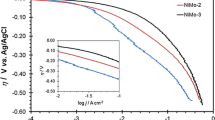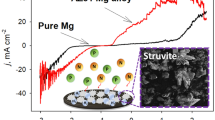Abstract
By utilizing the characteristics of amorphous alloys capable of possessing specific electrocatalytic activity and corrosion resistance by alloying and surface activation treatment, an attempt was made to find amorphous alloys which are active as the anode material for production of sodium hypochlorite by electrolysis of seawater. Amorphous Ni-Nb and Ni-Ta alloys containing only 0.5–2.0 at % palladium and other platinum group metals showed a very high activity for chlorine production by electrolysis of 0.5M NaCl at 30°C when they were previously immersed in 46% HF for surface activation. The current efficiency of these surface-activated alloys for chlorine evolution considerably exceeded that of the currently used, most active Pt-Ir/Ti electrode for electrolysis of seawater. The surface activation treatment resulted in preferential dissolution of alloy constituents unnecessary for the electrocatalytic activity, i.e. nickel and valve metals, with a consequent enrichment of electrocatalytically active platinum group elements in the surface-activated layer. The corrosion weight loss of the surface-activated amorphous alloys under the steady state conditions for chlorine production was undetectable by a microbalance.
Similar content being viewed by others
References
M. Naka, K. Hashimoto and T. Masumoto,J. Japan Inst. Metals 38 (1974) 835.
K. Hashimoto, ‘Rapidly Quenched Metals’, Proceedings of 5th International Conference on Rapidly Quenched Metals (edited by S. Steeb and H. Warlimont), Elsevier Science Publishers, Amsterdam (1985) Vol. II, p. 1449, p. 1109.
M. Hara, K. Hashimoto and T. Masumoto,Electrochim. Acta 25 (1980) 1091.
,J. Appl. Electrochem. 13 (1983) 295.
,J. Non-cryst. Solids 54 (1985) 85.
M. Hara, K. Asami, K. Hashimoto and T. Masumoto,Denki Kagaku 53 (1985) 785.
,Electrochim. Acta 31 (1986) 481.
N. Kumagai, A. Kawashima, K. Asami and K. Hashimoto, ‘Rapidly Quenched Metals’, Proceedings of 5th International Conference on Rapidly Quenched Metals (edited by S. Steeb and H. Warlimont), Elsevier Science Publishers, Amsterdam (1985) Vol. II, p. 1795.
,J. Appl. Electrochem. 16 (1986) 565.
A. Kawashima and K. Hashimoto, ‘Rapidly Quenched Metals’, Proceedings of 4th International Conference on Rapidly Quenched Metals (edited by T. Masumoto and K. Suzuki), The Japan Institute of Metals, Sendai (1982) Vol. II, p. 1427.
, Sci. Rep. Res. Inst. Tohoku University A-31 (1983) 174.
N. Kumagai, K. Asami and K. Hashimoto,J. Noncryst. Solids 87 (1986) 123.
N. Kumagai, K. Asami, A. Kawashima and K. Hashimoto,J. Electrochem. Soc. 133 (1986) 1876.
M. Naka, K. Hashimoto and T. Masumoto,J. Noncryst. Solids 30 (1978) 29.
M. Naka, K. Asami, K. Hashimoto and T. Masumoto, ‘Titanium ‘80’, Proceedings of 4th International Conference on Titanium (edited by H. Kimura and O. Izumi), The Metallurgical Society of AIME, Warrendale, PA (1981) Vol. 4, p. 2677.
T. D. Burleigh and R. M. Latanision, ‘Passivity of Metals and Semiconductors’, Proceedings of 5th International Symposium on Passivity (edited by M. Froment), Elsevier Science Publishers, Amsterdam (1983) p. 321.
K. Shimamura, A. Kawashima, K. Asami and K. Hashimoto, Sci. Rep. Res. Inst. Tohoku University, A-33 (1986).
K. Hashimoto, M. Naka, K. Asami and T. Masumoto,Corros. Eng. (Boshoku Gijutsu) 27 (1978) 279.
K. Hashimoto, K. Asami, M. Naka and T. Masumoto,Corros. Sci. 19 (1979) 857.
K. Hashimoto, K. Osada, T. Masumoto and S. Shimodaira,16 (1976) 71.
K. Hashimoto and K. Asami, ‘Passivity of Metals’, (edited by R. P. Frankenthal and J. Kruger), The Corrosion Monograph Series, The Electrochemical Society, Princeton, NJ (1978) p. 749.
K. Hashimoto, ‘Passivity of Metals and Semiconductors’, Proceedings of 5th International Symposium on Passivity (edited by M. Froment), Elsevier Science Publishers, Amsterdam (1983) p. 235.
M. Hara, K. Asami, K. Hashimoto and T. Masumoto,Corros. Eng. (Boshoku Gijutsu) 32 (1983) 363.
,Electrochim Acta 28 (1983) 1073.
Author information
Authors and Affiliations
Rights and permissions
About this article
Cite this article
Kumagai, N., Samata, Y., Kawashima, A. et al. Anodic characteristics of amorphous nickel-value metal alloys containing small amounts of platinum group elements in 0.5 M NaCl. J Appl Electrochem 17, 347–356 (1987). https://doi.org/10.1007/BF01023301
Received:
Revised:
Issue Date:
DOI: https://doi.org/10.1007/BF01023301




